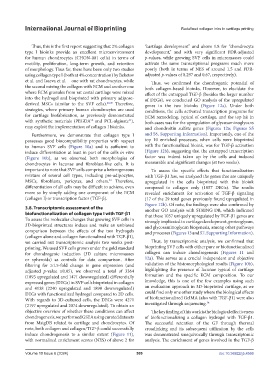Page 517 - IJB-10-6
P. 517
International Journal of Bioprinting Redefined collagen inks in cartilage printing
Thus, this is the first report suggesting that 2% collagen “cartilage development” and above 1.8 for “chondrocyte
type I bioinks provide an excellent microenvironment development,” and with very significant FDR-adjusted
for human chondrocytes (CHON-001 cells) in terms of p-values, while growing SVF cells in micromasses could
motility, proliferation, long-term growth, and retention activate the same transcriptional programs much more
of morphology. Thus far, there have been only two studies poorly (both in terms of NES of around 1.5 and FDR-
using collagen type I (both at 4% concentration) by Beketov adjusted p-values of 0.297 and 0.67, respectively).
et al. and Isaeva et al. – one with rat chondrocytes, while Thus, we confirmed the chondrogenic potential of
the second mixing the collagen with ECM and another one both collagen-based bioinks. However, to elucidate the
where ECM granules from rat costal cartilage were mixed effect of the entrapped TGF-β (besides the larger number
into the hydrogel and bioprinted with primary adipose- of DEGs), we conducted GO analysis of the upregulated
derived MSCs (similar to the SVF cells). 48,49 Therefore, genes in the two bioinks (Figure 12a). Under both
strategies, where primary human chondrocytes are used conditions, the cells activated transcription programs for
for cartilage biofabrication, as previously demonstrated ECM remodeling, typical of cartilage, and the top hit in
52
with synthetic materials (PEGDA and PCL-alginate ), both cases was for the upregulation of glycosaminoglycans
31
may exploit the implementation of collagen I bioinks. and chondroitin sulfate genes (Figures 12a; Figures S5
Furthermore, we demonstrate that collagen type I and S6, Supporting Information). Importantly, one of the
possesses good biocompatibility properties with respect top 10 enriched processes, when cells were bioprinted
to human SVF cells (Figure 10a) and is sufficient to with the functionalized bioink, was for TGF-β activation
induce differentiation at least in part of the cells in vitro (Figure 12b), suggesting that the entrapped transcription
(Figure 10b), as we observed both morphologies of factor was indeed taken up by the cells and induced
chondrocytes in lacunae and fibroblast-like cells. It is measurable and significant changes (at two weeks).
important to note that SVF cells comprise a heterogeneous To assess the specific effects that functionalization
mixture of several cell types, including pre-adipocytes, with TGF-β1 has, we analyzed the genes that are uniquely
MSCs, fibroblasts, pericytes, and others. Therefore, upregulated in the cells bioprinted with this bioink
53
differentiation of all cells may be difficult to achieve, even compared to collagen only (1057 DEGs). The results
more so by simply adding one component of the ECM revealed enrichment for activation of TGF-β signaling
(collagen I) or transcription factor (TGF-β). (17 of the 29 total genes previously found upregulated in
Figure 12b). Of note, the findings were also confirmed by
3.8. Transcriptomic assessment of the another GO analysis with STRING DB, which indicated
biofunctionalization of collagen type I with TGF-β1 that these 1057 uniquely upregulated by TGF-β1 genes are
To assess the molecular changes that growing SVF cells in strongly implicated in cartilage development, proteoglycan,
3D-bioprinted structures induce and make an unbiased and glycosaminoglycan biogenesis, among other pathways
comparison between the effects of the two hydrogels and processes (Figures 13 and S7, Supporting Information).
(collagen alone and collagen functionalized with TGF-β1),
we carried out transcriptomic analysis two weeks post- Thus, by transcriptomic analysis, we confirmed that
printing. We used SVF cells grown under the gold standard bioprinting SVF cells with either pure or biofunctionalized
for chondrogenic induction (3D culture micromasses collagen can induce chondrogenesis (Figures 11 and
or spheroids) as controls for data comparison. After 12a). This serves as a crucial independent and objective
filtering for ≥1.5-fold change in gene expression (and validation of the histomorphological results (Figure 10b),
adjusted p-value ≤0.05), we observed a total of 3364 highlighting the presence of lacunae typical of cartilage
(1893 upregulated and 1471 downregulated) differentially formation and the specific ECM composition. To our
expressed genes (DEGs) in SVF cells bioprinted in collagen knowledge, this is one of the few examples using such
and 4138 (2240 upregulated and 1898 downregulated) an evaluation approach in 3D-bioprinted cartilage, as we
DEGs with functionalized hydrogel compared to 2D cells. could find only one other study where the biological effects
With regards to 3D-cultured cells, the DEGs were 4271 of biofunctionalized GelMA (also with TGF-β1) were also
(2197 upregulated and 2074 downregulated). To obtain an investigated through sequencing. 54
objective overview of whether these conditions can affect The key finding of this work is the biological effectiveness
chondrogenesis, we performed GSEA using curated datasets of biofunctionalizing a collagen hydrogel with TGF-β1.
from MsigDB related to cartilage and chondrocytes. Of The successful retention of the GF through thermal
note, both collagen and collagen/TGF-β could successfully crosslinking and its subsequent utilization by the cells
induce chondrogenesis to a similar extent (Figure 11), was demonstrated unequivocally through transcriptomic
with normalized enrichment scores (NES) of above 2 for analysis. The enrichment of genes involved in the TGF-β
Volume 10 Issue 6 (2024) 509 doi: 10.36922/ijb.4566

